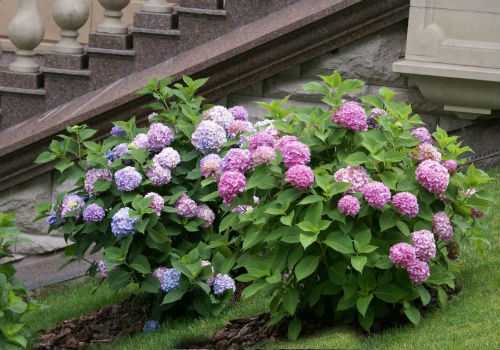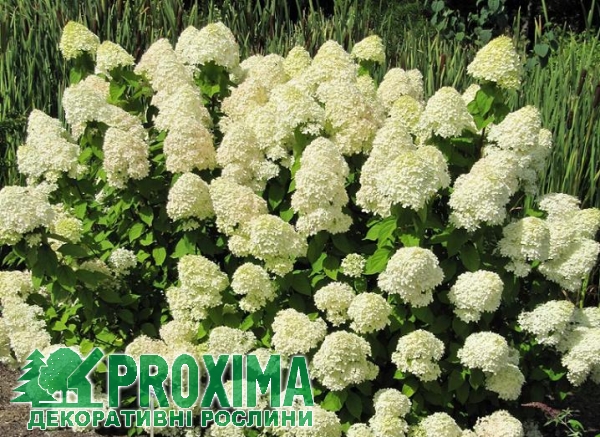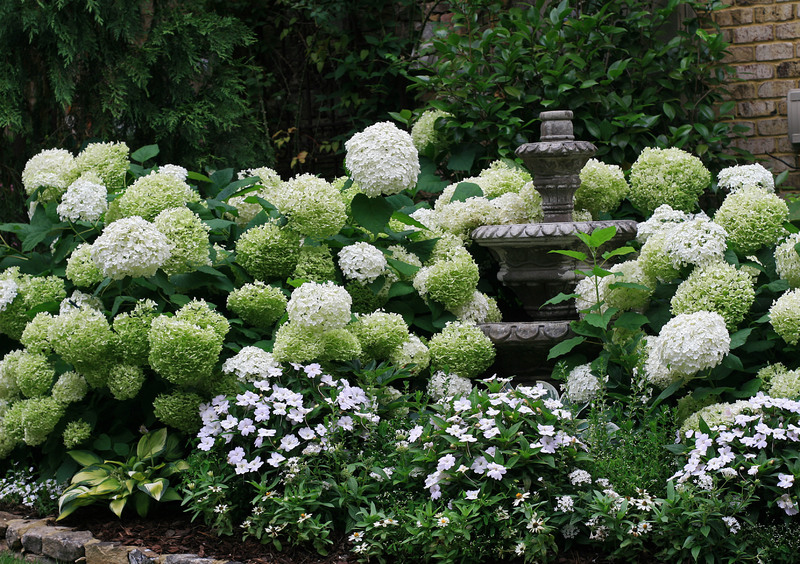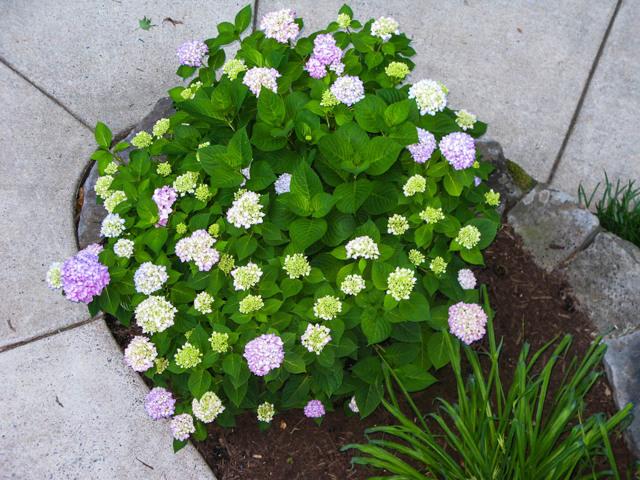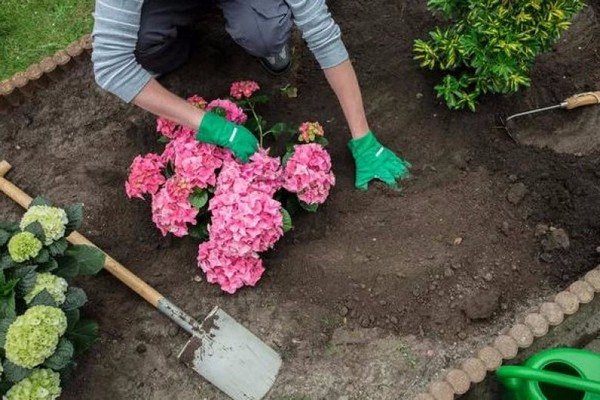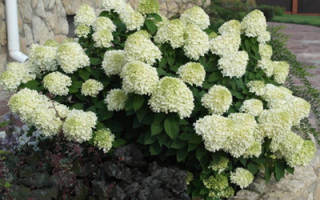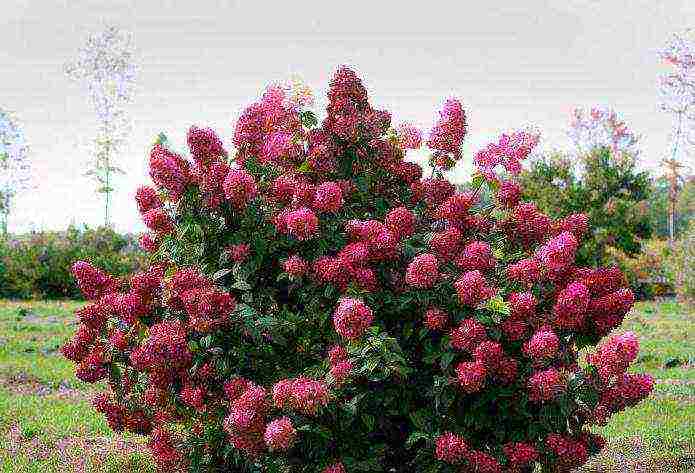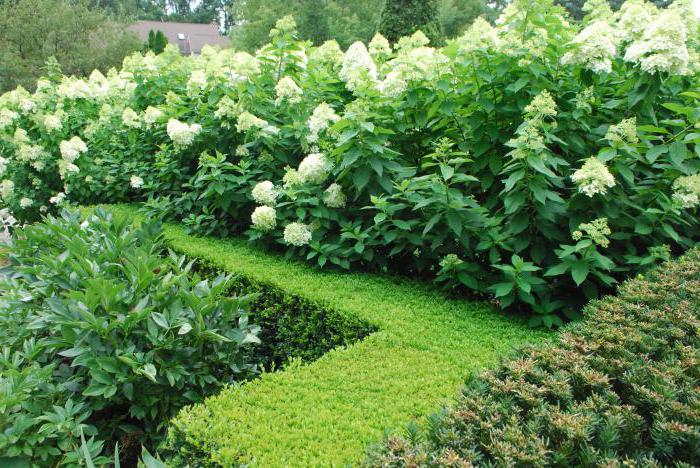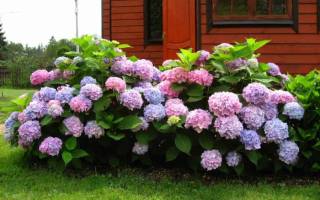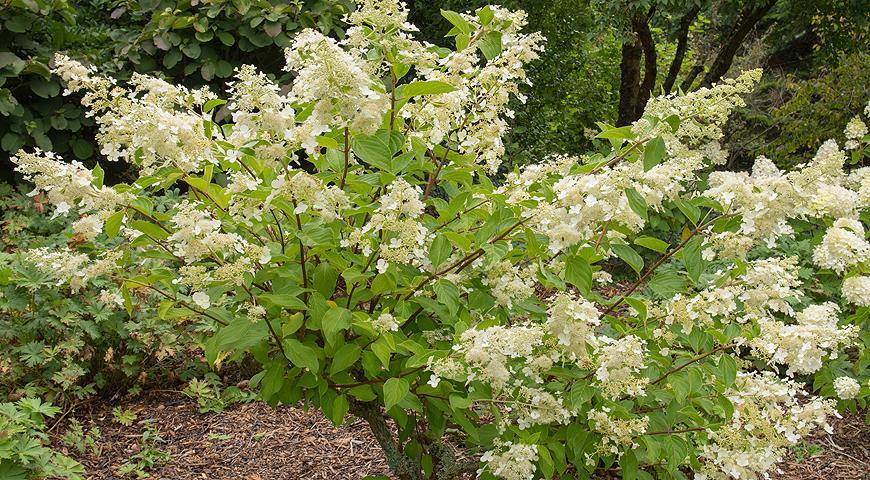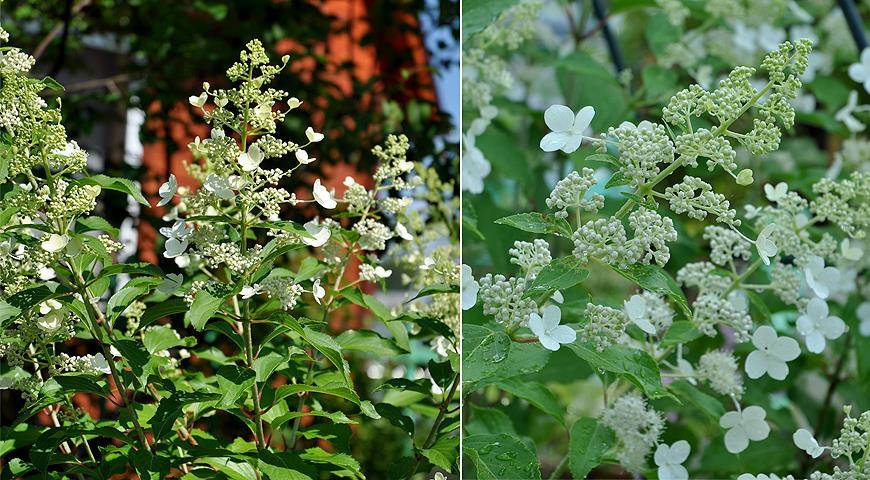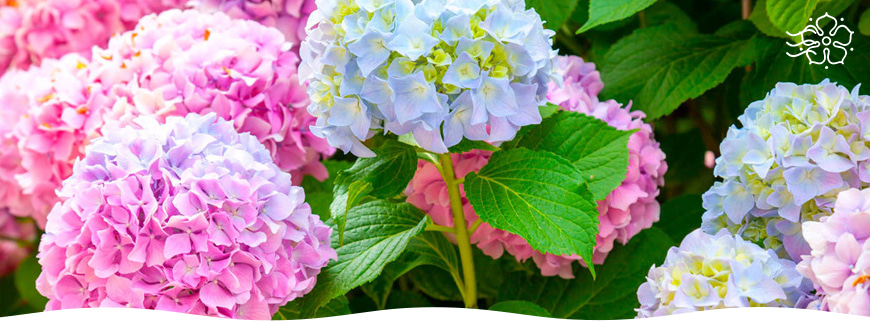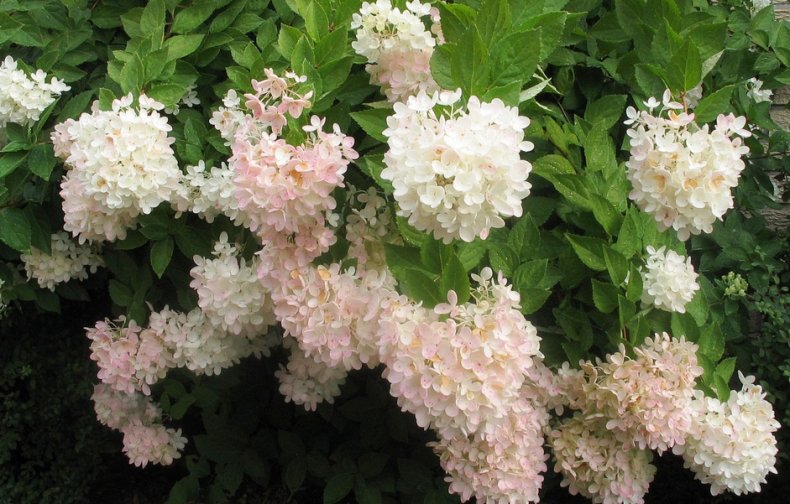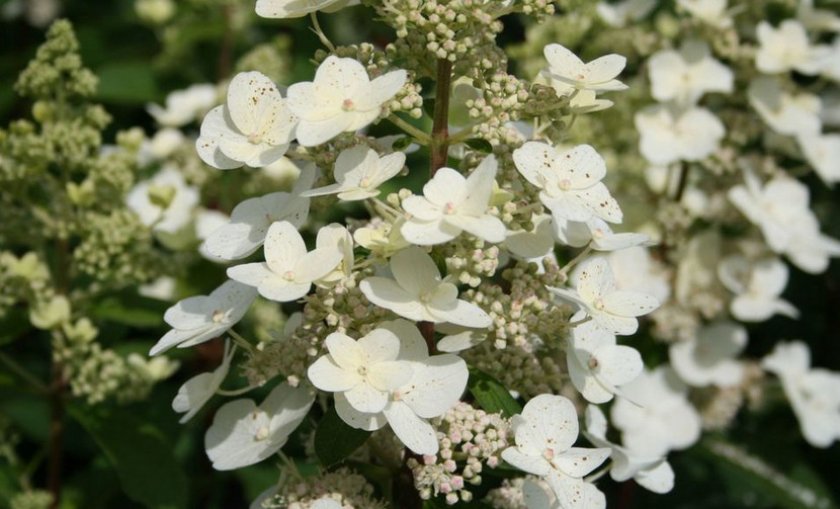Suitable for landscaping park areas
Hydrangea paniculata Unic - planting and care:
1. Variety Unique (Unique)
Characteristic:
the height of an adult bush reaches a height of 3 m, the span of the crown can exceed 5 m;
large green pointed ovoid leaves up to 15 cm long and 8 cm wide;
the leaf plate is rough, by autumn it becomes yellow;
large panicle inflorescences 30 cm with large pink buds opening into a snow-white flower;
during the flowering period, the flower turns pink and turns into a beautiful pinkish cloud;
depending on the quality of the soil, the color may be less or more saturated;
fast-growing superficial root system;
shoots are flexible and long, red;
the plant is frost-resistant, takes root in central Russia;
refers to fast-growing, gives an increase of up to 30 cm;
blooms from July to September;
the more acidic the soil, the brighter the flowers;
moisture and heat-loving;
the flowers are sterile, so the propagation method is vegetative;
responsive to frequent feeding
2. Landing rules
Characteristic:
the optimal time for planting in open ground is early spring or late August;
autumn planting is suitable only for the southern regions of Russia;
hydrangea is demanding on moisture;
the planting pit should be made voluminous with a good drainage layer;
before planting in the hole, fertilize and prepare rich soil;
after planting under the plant, pour a bucket of water;
culture prefers sunny places;
the soil should be rich in nutrients, loose, moderately moist and acidic;
you can create an acidic environment with milk whey, pine sawdust or peat;
does not like the neighborhood with perennials, since loosening damages the roots;
every 2 weeks, carry out root feeding with humus, potash or phosphorus fertilizers;
a young plant must be covered for the winter
3. Care
Characteristic:
a young bush needs regular abundant watering;
the soil under the bush should be moist and loose;
to preserve moisture, mulch the root circle with sawdust;
carry out the first feeding immediately after the snow melts, for this it is good to use slurry;
the second feeding is carried out during the ripening of the buds with potassium superphosphate and urea;
the third feeding is carried out with mineral fertilizers during abundant flowering;
the fourth before wintering with a special composition for hydrangeas;
before feeding, pruning is carried out: sanitary molding and rejuvenating;
sanitary and molding is carried out in the spring before bud break, rejuvenating in the fall, so that young shoots appear in the spring;
in order to maintain the strength of the plant for future flowering, faded inflorescences should be cut off in the fall;
plants should be planted in protected places from the wind, since flexible shoots easily break from its effects
4. Preparing for winter
Characteristic:
even taking into account the rather high frost resistance, the plant needs protection for the winter;
cut leaves from branches;
remove the sick and broken;
the root system needs special protection, especially in those regions where little snow falls and the ground freezes;
the trunk circle should be mulched with peat, sawdust or rotted manure to a height of 10-20 cm;
Tie the branches into bunches and press them to the ground;
on top they can be covered with spruce branches or a frame can be built, which can be covered with burlap or non-woven material
5. Reproduction
Characteristic:
the most common method is grafting;
put the cut branches in water for 5-7 days;
then form a stalk with 3-4 internodes from them;
treat the lower cut with a growth stimulator;
plant in a soil mixture of peat and sand 1: 1;
cuttings should be grown indoors until spring;
when the ground warms up in spring, then the grown plants can be planted in a permanent place;
the plant does not tolerate division of the bush;
when watering, it is sometimes necessary to add potassium permanganate to prevent plant diseases
6
Protection against diseases and pests
Characteristic:
the variety is often exposed to various diseases, therefore, special attention should be paid to prevention;
at the first signs of powdery mildew (the appearance of spots with an oily structure and a dark bloom), treat the bush with a solution of copper sulfate and laundry soap;
for severe lesions, use fungicides;
with tracheomycotic wilting, diseased shoots should be removed;
process the sections with a solution of potassium permanganate;
to promulgate the land with wood ash and powdered sulfur;
you should also monitor the infestation of insects and apply appropriate chemicals in a timely manner
Landscape designers prefer to plant Unique in park areas for resistance to air pollution and a spreading dense crown
 The bush is easy to cut, which can be used to give it any shape
The bush is easy to cut, which can be used to give it any shape
Variety of hydrangea
The homeland of some species is considered to be North and South America, others are China, Japan, Sakhalin, the Kuril Islands. There are 70-80 types of shrubs. But, unfortunately, not all grow in our strip. Let's dwell on the four types of hydrangea that are most common in our area:
- tree-like - lat. name Hydrangéa arboréscens
- large-leaved hydrangea or large-leaved hydrangea - lat. name Hydrángea macrophýlla
- petiolate - lat. name Hydrangea preslii
- panicle - lat. name Hydrangea paniculata
Treelike hydrangea is a very resistant and completely unpretentious shrub, some varieties of which can reach 6 m in height. Blooms from July to October. The inflorescences are round, mostly white, cream and pale pink. Moisture-loving shrub, grows well in partial shade. Can be planted singly or in groups. The most common varieties:
- Annabelle. A medium-sized spherical plant with white inflorescences.
- Hayes Starburst. Domed inflorescences are white. It blooms for a long time due to the formation of new spherical flowers in the center of the flower.
- White Dome. Dome-shaped bush. A large numerous inflorescence in the center of the petals are creamy white, snow-white along the edges.

Hydrangea tree-like (lat.Hydrangéa arboréscens)
The type of large-leaved hydrangea differs from other species in a variety of shades. Pink, white, purple, blue, lilac or violet - for all its riot of colors, the plant looks organically with other representatives of the flora, even dead wood. Such a hydrangea variety is not resistant to frosty weather conditions. This is due to the biology of the plant: the ovary is formed at the ends of the shoots of the last year. Poor winter hardiness from the fact that the shoots freeze slightly during cold weather, as a result, the bush does not bloom. For this reason, before the onset of cold weather and frost, the plant is carefully covered or hidden in the basement, where the temperature does not drop below zero.
In the spring, do not rush to open or plant a hydrangea on the site until the air warms up enough. According to the observations of gardeners, she is more afraid of spring frosts. A temperature of -5 in spring is detrimental to the hydrangea buds.

Large-leaved hydrangea (Latin Hydrángea macrophýlla)
Hydrangea tree care (video)
Recently, varieties have been bred that are not afraid of frost. Ovaries are formed not only on the shoots of the last year, but also on the shoots of the current one.
For example, the Endless Summer series:
- Blushing Bride. White flowers that turn pinkish over time
- Original (Original) Spherical inflorescence of pink or pale lilac color.
- Twist And Shout. Flowers of this variety are small central and large marginal.

Hydrangea Series Endless Summer Twist And Shout
The Forever and Ever series change color, depending on the characteristics of the soil:
- Pink (Pink) - pink, but on more acidic soil turns blue
- Blue (Blue) - on the contrary from the Pink variety, blue, and on alkaline soil they turn pink
- Red - red at the beginning of the season, purple at the end
- Dichromatik (Dihromatik) - two-color flowers, white with a pink eye.
The main advantage of frost-resistant large-leaved varieties is long flowering. After the shrub blooms for the first time, buds reappear after about five to six weeks. This continues several times. As a result, the shrub is decorated with color in good weather conditions from June to October.

Hydrangea series Forever and Ever
Growing seedlings
Sowing hydrangea seeds for seedlings is carried out at the end of winter or in the first month of spring, sometimes in autumn
In order for the seeds to sprout well and give healthy seedlings, it is important to pay attention to the quality of the soil, the temperature and humidity in the room where the young plants will be.
Table 2. Step-by-step instructions for growing hydrangea seedlings.
| Step, no. | Description |
| Step 1 | Place the seeds on a cotton pad, cover with a second disc on top and moisten them well. For disinfection, the inoculum can be soaked in a similar way in a weak solution of potassium permanganate or copper sulfate. |
| Step 2 | Sowing substrate should be light and loose. The best option is peat, humus, river sand, leaf and sod soil. You can go the simple way - take the land from wormholes, which also has useful qualities. |
| Step 3 | Fill a small container with earth so that the surface is 2-3 cm below the sides. Spread the swollen seeds on the soil - it is not necessary to deepen too much, it is enough to sprinkle them with soil a little. Cover the boxes with transparent material |
| Step 4 | Place containers in a place with good, diffused lighting, the optimum temperature is 14-20 degrees. Occasionally, the shelter should be cleaned up and sprayed on the soil with a spray bottle, making sure that the soil is not too dry or wet. |
| Step 5 | After the first shoots appear (after about a month and a half), the glass should be removed, and as soon as the seedlings grow 2 true leaves, dive them into separate cups |
| Step 6 | The plants are transplanted a second time in May, and the pots should be about 7 cm in diameter, after which each of them is looked after separately |
Seedlings can be grown from the seeds of the culture for subsequent transplantation.
Seedling care at home
In open ground, seedlings of a culture can be planted only after two years, and during this period they should grow indoors. Caring for young hydrangeas does not differ from caring for other indoor flowers, but it has some subtleties:
- plants need to be placed in a place with intense but diffused light - direct ultraviolet rays can burn the leaves, and lack of lighting will lead to growth failure;
- the temperature in the room should be at least 20 degrees, even in the summer heat, and in the winter the pots are placed in a cool, dark place;
- watering hydrangeas requires constant, but moderate, and for it you need to use settled or filtered, slightly heated water, avoiding stagnant moisture;
- hydrangeas prefer high atmospheric humidity, so they need to be constantly sprayed with a spray bottle or placed bowls of water next to the pots;
- monthly plants are recommended to be watered with slightly acidified water;
- seedlings are fed every two weeks in summer and spring, using special mixtures for hydrangeas and azaleas, in autumn, feeding is reduced, and in winter, they are stopped altogether;
- it is better to cut off the buds of seedlings in the first year so that they do not disturb the growth of seedlings.
Varieties that are suitable for indoor cultivation do not need to be planted in a flower bed - they can grow in a pot for about 5 years.
Hydrangea seedlings are transferred to an open place only after two years
Landing in an open place
Before planting plants, they need to be hardened - left with an open window, gradually increasing the airing time, and then take them out into the street, protecting them from drafts and direct sunlight. Requirements for the site and soil composition are similar to those that are put forward when sowing seeds.
It is necessary to carry out the procedure in the spring, so that the seedlings take root well by the first frosts. The diameter of the holes for seedlings should be twice the root (about 30x30x30 cm) so that they feel free, and the distance between the bushes is about a meter. Superphosphate with humus is poured at the bottom of each hole, then drainage material, the plant is planted and the roots are covered, leaving the root collar on top. After planting the bushes, the soil around them is mulched to prevent moisture evaporation.
It is better to transplant seedlings to garden plots and flower beds in spring.
Planting and leaving
Planting of hydrangeas of the Unique variety in open ground is carried out in spring or autumn. The optimum age for a young seedling is two to three years. When planting plants, a certain distance between them should be observed (at least three meters), taking into account the dimensional characteristics of already mature bushes. Hydrangeas grow well and bloom profusely on fertile acidic, slightly acidic or neutral soil. Calcareous soils are "contraindicated" for them. For disembarkation, it is recommended to choose an area that is most protected from drafts.
Landing
Initially, you need to dig a hole with a diameter and depth of about 50-60 centimeters. A ten centimeter drainage layer is laid on its bottom. Shards of a clay pot, pieces of broken brick, small stones are excellent as drainage. Top covered with a fertile soil mixture and watered with one bucket of water.
Next, you need to put a seedling and carefully distribute the root system over the fossa
It is important to remember that the root collar must be at ground level. Fill up with the remaining earth, tamp it and wate it again with one bucket of water
This variety is considered one of the unpretentious ones, so even a beginner can take care of the planted hydrangea.
Watering
The first days after planting, the plant requires more reverent care. Frequent watering is required. Once it is in place, it is enough to water it five to seven times a season. In very dry weather, periodic spraying of the bushes is recommended. To obtain the maximum result, the soil around the bush is loosened to a depth of up to five centimeters, and weeds are removed.
In order to prevent their strong growth around the bush, mulching material can be used, which also retains moisture well at the roots and prevents the soil from drying out.
Top dressing
It is advised to fertilize panicle hydrangea throughout the growing season (except for winter), but no more than three times a season. The first fertilization cycle begins two to three days after planting. Rotten manure is excellent as a top dressing. You can also use mineral fertilizers. In the spring they are fed with nitrogenous substances, in the summer they contain potassium and phosphorus, which contribute to active growth and flowering. It is allowed to water under the rhizomes and along the crown with potassium permanganate of low concentration in order to increase the strength of the shoots.
Pruning
In temperate climates, circumcision is carried out in the spring before the start of active sap flow.In the course of these measures, obsolete flowers are removed to real strong buds, the shoots of the previous year are shortened by a third, diseased and weak branches are cut out at the root, as well as those that are densely located next to each other. Some people remove dead buds and form a bush in the fall. However, experts categorically do not recommend doing this, arguing that they are a kind of protection from frost for new buds.
 In non-severe winters, the root system of the plant is covered with leaves, straw, dry grass, sawdust, spruce branches, and sprinkled with snow. In severe frosts, they are additionally wrapped with a covering material (spunbond) or film.
In non-severe winters, the root system of the plant is covered with leaves, straw, dry grass, sawdust, spruce branches, and sprinkled with snow. In severe frosts, they are additionally wrapped with a covering material (spunbond) or film.
Landing rules
Before planting a seedling in the ground, you must choose the right one, as well as take into account some other important points.
It is very important to purchase good quality seedlings, they must be healthy, without the presence of any disease factors
Seedlings of 4-5 years of age take root best of all.
Hydrangea is considered a moisture-loving plant, and therefore, when buying a seedling, it is very important to pay attention to the root system, which must be well developed and moist, otherwise the plant simply will not take root in the open field.
Before planting, you need to choose the right place where the hydrangea will grow. It is best to pay attention to open areas without drafts.
Despite the fact that winter-hardy varieties are not afraid of winds, it is best to minimize their effect on plants.
Most often, hydrangeas are planted along fences, but at the same time, such a place should be well lit. In terms of soil, preference should be given to slightly acidic or moderately acidic, but alkaline soil is best avoided, in which hydrangea can begin to hurt. According to the recommendations of experts, sand, peat and sod land must be present in the soil. If something is missing, then you can use fertilizing and fertilization in the future.
As for the time and timing of planting, in Siberia it is best to plant a hydrangea in the spring after the frost has receded. This time is considered the most comfortable time for plants to take root in the open field.
So, after choosing a plant and a place for planting it, it is necessary to begin the process of preparation itself and directly planting a hydrangea.
For small seedlings, holes of 50 to 50 are quite suitable, for large ones a little more: 70 to 70 or 80 to 80, to a depth of no more than 60 cm.If several seedlings are planted at once, then the distance between them should be at least 2.5 meters.
Before planting, the dug holes should be moistened; on average, this requires 2-3 buckets of water. After the water is absorbed, a mixture of fertilizers and dressings must be placed in the hole. Usually, for this, the soil is mixed with sand, peat and humus. If the soil needs to be acidified, you can add a mixture of spruce or pine needles.
Before planting, all excess shoots from the hydrangea seedling should be removed, and the roots should be slightly shortened
The main thing is not to overdo it.
It is very important to place the seedling correctly in a pre-prepared hole. Its root collar should be flush with the ground.
After covering the roots, the plant must be watered again.
To retain moisture, you can mulch the soil around the trunk of the plant, sprinkling it with a mixture of peat and needles, you can also use dry leaves.
Propagation of hydrangea
Over time, gardeners have a need to propagate their favorite beauty Strawberry Blossom hydrangea. Every person can do this. Moreover, there are several ways of reproduction:
- cuttings;
- layering;
- dividing the bush;
- seeds.
Hydrangea cuttings begin to develop
Cuttings
This method is used most often.It is carried out in most cases in the summer, so that the plant has the opportunity to root well and prepare for wintering. For planting, young branches are selected that have not yet had time to woody. The upper part of the cutting is cut off, the remainder is divided into several cuttings, while making sure that four or six leaves remain on them.
The operation must be carried out on a cloudy day so that moisture does not quickly evaporate from the planting material. Therefore, the cut branches should be immediately placed in a bowl of water.
Important! All circumcision processes are done exclusively with sterile instruments. After several days, the cuttings are planted in the prepared soil, before that the lower part of them is treated with stimulants for root formation, the upper part is sealed with paraffin
After several days, the cuttings are planted in the prepared soil, before that, the lower part of them is treated with stimulants for root formation, the upper part is sealed with paraffin.
To plant the cuttings, you need to prepare the soil from sand and peat. Each part of the twig is planted to a depth of three centimeters and covered with a jar. In a month, the first leaves will appear, which means that the plant has taken root. Only well-rooted plants can be planted in open ground, while pre-hardening them.
Growing from cuttings
It is customary to propagate the bush by layering in the autumn, when the plant is already being prepared for the coming winter. For this, the soil is loosened in the root zone. Dig a small groove and put a branch of a bush in it. In this case, you need to pin it to the ground in several places.
The top of the branch should remain above the surface. After two weeks, the branch will sprout the first shoots that need to be looked after, and they are not transplanted to another place until next spring.
Dividing the bush
The easiest and most effective way is to divide the bush. The procedure is carried out in the spring to enable young bushes to adapt and take root. Before planting, you need to prepare the pits.
Hydrangea bush
The hydrangea shrub grows well and gives young shoots. It is it that needs to be carefully separated from the mother bush, without damaging the root system, and planted in prepared holes.
Conclusion
In general, many gardeners who have grown this hydrangea variety say that it is a truly unique decoration that can become indispensable for any home garden. At the same time, the bush is completely unpretentious if we talk about care measures. Therefore, it does not take much effort and time from the gardener to get a decent and attractive result.
Over the years, the Tardiva panicle hydrangea will give the gardener incredibly attractive inflorescences, and the scent will attract many honey insects. One way or another, subject to agricultural technology, you can extend the life of the bush, and sometimes give it a second youth, when even the oldest bushes begin to bloom profusely, which, of course, attracts gardeners.


